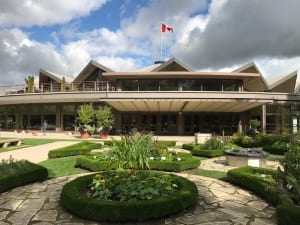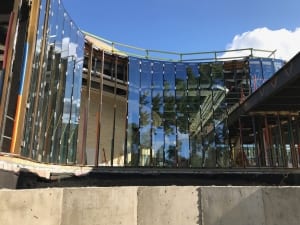Stratford, Ontario: Canada’s cultural tourism destination
The article below, which I’ve updated by way of taking into account the COVID-19 pandemic, is from the Spring 2020 issue of the Architectural Conservancy Ontario Acorn Magazine.
An April 27, 2020 CBC article is entitled: “Stratford Festival puts entire 2020 season on hold: Risk of contagion ‘extremely high’ between cast and crew, officials say.”
An April 27, 2020 Our Windsor article is entitled: “Stratford Festival suspends 2020 season indefinitely due to COVID-19.”
The text of the Spring 2020 ACO article reads:
Stratford, Ontario: Canada’s cultural tourism destination
By Jaan Pill
The Stratford Festival began with a suitably spectacular opening performance under a huge theatrical tent, raised at the edge of an impressive park system along the Avon River – populated then as now by swans, ducks, and geese – sixty-seven years ago.
The story of how the Stratford Festival, North America’s largest repertory theatre, now bringing over 500,00 visitors a year to Stratford, began at the Festival Theatre on July 13, 1953 – with a stunning evening performance of Richard III, starring Alex Guinness in the title role – has been frequently told.
In Fifty Seasons at Stratford (2002), Robert Cushman describes the moment when the performance ended: “The Canadian response was bemused – but ecstatic. A first-night standing ovation (not the automatic event it is now) lasted five minutes: an eternity in theatre time. Everybody knew that history had been made.”

Original model of the Festival thrust stage, a new variant on a centuries-old idea, designed by Tanya Moiseiwitsch in consultation with Tyrone Guthrie, 1953. Though Moiseiwitsch’s stage has been modified a few times since its original incarnation, its basic architecture remains the same today. Photo courtesy of Stratford Festival Archives
Richard III, along with the season’s second play, All’s Well that Ends Well, starring Irene Worth, was performed on a thrust stage designed by theatrical designer Tanya Moiseiwitsch, in collaboration with artistic director Tyrone Guthrie, who had previously visited Canada to produce and direct a documentary drama series (1930-1931) for the Canadian National Railway Radio Department. Initially, the amphitheatre – constructed in parkland next to the historic Stratford Normal School – was covered by a theatrical tent. In 1957, a permanent roof, designed by Toronto architect Robert Fairfield, was installed.
“The design was strikingly original,” John Pettigrew and Jamie Portman observe, regarding Fairfield’s task, in Stratford: The First Thirty Years (1985). “One of the modern world’s few round buildings when it was erected, it was patterned not on any other building but on the tent itself. Fairfield aimed strongly at capturing something of the tent’s atmosphere, as can be seen in the use of colour and in the fluted roof capped with coronet and flagpole.”
Fairfield also preserved the centrality of the thrust stage by ensuring the stage’s centre pillar would be at the very centre of the new building. The thrust stage design, with the audience seated on three sides of it, fosters intimacy between actors and audience, requires minimal scenery, and enables quick and effortless scene changes. With good seats available in a wide arc around the stage, the design also maximizes ticket revenue.

The Festival Theatre, designed by architect Robert Fairfield in close consultation with the Stratford Festival board of directors and theatre staff, was awarded the Vincent Massey Gold Medal for Architecture in 1958. The theatre features a thrust stage. Jaan Pill photo
Richard III was scheduled, before COVID-19 appeared on the scene, to be performed again in 2020, starring Colm Feore in the title role, at the Festival’s new $100-million Tom Patterson Theatre. All’s Well that Ends Well, featuring Jessica B. Hill and Seana McKenna, was also scheduled to be staged again.
Park system
Tom Patterson, a Toronto journalist who grew up in Stratford, was a key player in founding of the Festival. Thomas Orr, an insurance broker, also played a strong role by helping save the riverside park system that runs through the heart of Stratford. Many others contributed, in making Patterson’s dream of a festival a reality.
By the early 1900s, land along the Avon River had been turned into industrial wasteland. Thomas Orr, working with Montreal landscape architect Frederick Todd, arranged for existing parks to be joined together and cleaned up, creating a pastoral scene.

Tom Patterson Theatre Centre construction site on parkland along the Avon River in Stratford: view looking south from Lakeside Drive east of Waterloo Street South. The theatre features a thrust stage. Jaan Pill photo
Then along came a proposal, by the Canadian Pacific Railway, to build a railway along the river. All at once, the park system was under threat. Many residents supported the proposal on grounds it would bring prosperity. Orr argued that keeping the parkland intact made better economic sense. A referendum in 1913 saved the parkland by a margin of 127 votes. Patterson and others have noted that, had the park system been destroyed, the Festival would not have happened.
Adjacent to the parkland, inside of which two Festival theatres are located, is an eminently walkable neighbourhood of century-old houses many featuring Architectural Conservancy Ontario heritage plaques. The Festival Area Ratepayers Association works to preserve the neighbourhood, with its luxuriant tree canopy, for future generations.
Four theatres
A music festival was also launched in 1953, in connection with the Festival. Given that the acoustics at the Festival Theatre were not ideal for music, an alternative space in the park system – the city’s Casino, which later became the Second Stage, and subsequently the Tom Patterson Theatre – became the Festival’s concert hall.
Initially there wasn’t much for visitors to do, when not attending plays. In 1953, a women’s organization served visitors meals in church basements. Subsequently, a vibrant restaurant scene has emerged.

The Avon Theatre – which features a proscenium stage – on Downie Street in downtown Stratford. The Studio Theatre – which features a thrust stage – is visible on the right (back of building). Jaan Pill photo
In the early sixties, when the Festival began staging musical theatre, it took over the lease at the Avon Theatre, which had opened in 1901. The theatre, with a proscenium stage, has served as a music hall, vaudeville house, and movie theatre until the Festival repurposed it again, back into a theatre.
The Festival rented the theatre each summer starting in 1956 for light operas and bought it in 1963. In 1964, the building was renovated. Afterwards, the exterior and front offices were reconstructed resulting in its current facade. In 1984, the backstage area was enlarged and a renovation completed in 2002 added the Studio Theatre, the Festival’s fourth theatre.
The story of the repurposing of the Avon Theatre concludes this standard version of the history of the Stratford Festival. I owe thanks to the Stratford Festival Archives for assistance in research. For further reading, especially regarding alternative versions of the story of Stratford, good sources include Shakespeare in Canada: A World Elsewhere? (2002), edited by Diana Brydon and Irena R. Mararyk; and Shakespeare and Canada: Remembrance of Ourselves (2017), edited by Irena R. Makaryk and Kathryn Prince.
About the author
A retired elementary teacher and writer who recently moved to Stratford, Jaan Pill has helped to preserve a large school property and several century-old houses in Toronto, as documented at his Preserved Stories website, which also features topics such as “How to prepare a five-minute presentation to the Committee of Adjustment.”
[End of article]
Previous posts about Stratford
The article is based on my interviews and my reading of accounts of the launch of the Stratford Festival. Many readers shared feedback in response to early drafts. I owe many thanks to each person who helped me during research and writing.
The following post has additional background about the history of the Stratford Festival:
Recasting History (2019) features highly informative analysis of CBC profiles of Canadian history

Leave a Reply
Want to join the discussion?Feel free to contribute!